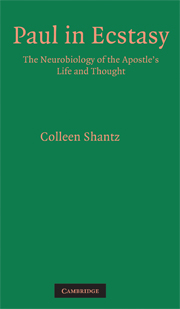Book contents
- Frontmatter
- Contents
- Acknowledgments
- Dedication
- Introduction
- 1 What Ecstasy? An Assessment of the Misregard
- 2 Paul's Brain: The Cognitive Neurology of Ecstasy
- 3 Paul's Voice: Parsing Paul's Ecstatic Discourse
- 4 Paul's Practice: Discerning Ecstasies in Practice
- 5 The Whole Paul: A Short Course in (Nondeterministic) Complexity
- Bibliography
- Index of Ancient Sources
- Index of Modern Authors
- Subject Index
4 - Paul's Practice: Discerning Ecstasies in Practice
Published online by Cambridge University Press: 06 January 2010
- Frontmatter
- Contents
- Acknowledgments
- Dedication
- Introduction
- 1 What Ecstasy? An Assessment of the Misregard
- 2 Paul's Brain: The Cognitive Neurology of Ecstasy
- 3 Paul's Voice: Parsing Paul's Ecstatic Discourse
- 4 Paul's Practice: Discerning Ecstasies in Practice
- 5 The Whole Paul: A Short Course in (Nondeterministic) Complexity
- Bibliography
- Index of Ancient Sources
- Index of Modern Authors
- Subject Index
Summary
Revival services are not simply theatre or variety shows; Revivalists are “making a joyful noise unto the Lord.” Ritual art takes place in a cosmic or sacred context. It is used to express beliefs that give meaning and purpose to existence, and it also makes existence seem beautiful.
– William WedenojaDo not confuse your finger with the moon.
– Zen proverbIn the last chapter, i discussed a number of points at which Paul speaks of ecstasy (and out of ecstasy) as a matter of course, without elaboration or qualification. At these times, ecstatic knowledge and practice are something he takes for granted and even invokes in the service of other – disputed – topics (for example, his apostleship). At other times, however, Paul raises the issue of religious ecstasy in order to clarify its practice or significance in a particular context (for example, glossolalia in Corinth). When this full range of talk of ecstasy is considered, the resulting discourse is complex and nuanced. For that reason, this chapter will seek an alternative to the common procedure of assigning Paul to one side or the other in an artificial binary assessment of religious ecstasy. Instead, this chapter strives to place Paul's comments within a coherent sense of the social dynamics of this public practice. What social logic might undergird Paul's statements? What kind of social power does this sort of religious experience wield in Christian origins? How is religious ecstasy controlled and interpreted within communities?
- Type
- Chapter
- Information
- Paul in EcstasyThe Neurobiology of the Apostle's Life and Thought, pp. 145 - 203Publisher: Cambridge University PressPrint publication year: 2009



